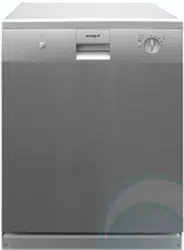Documents: Go to download!
- User Manual - (English)
- Description of the controls
- Operating instructions
- Cleaning and maintenance
- Troubleshooting
Table of contents
Owners' Guide Dishwashers
Description of the controls
Front panel
All the dishwasher control are grouped on the front panel. Programming and option selection are only possible with the door closed.

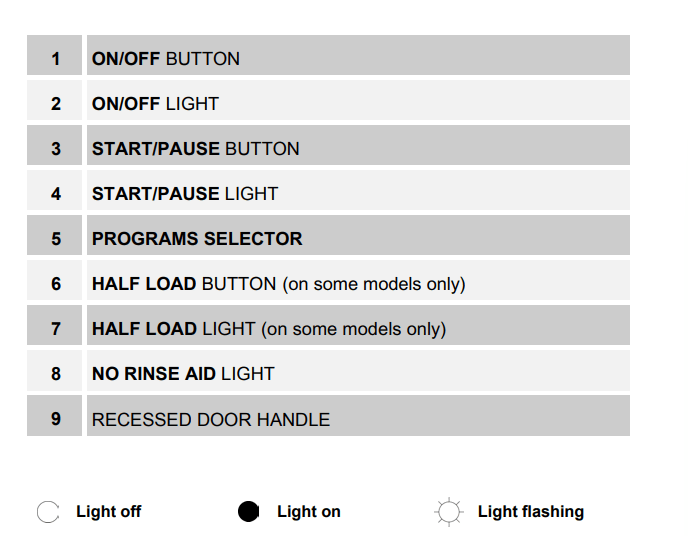
SETTING THE WASHING PROGRAM
To select the most suitable program for the dishes to be washed refer to the table below, which indicates the most appropriate program according to dish type and degree of soiling.
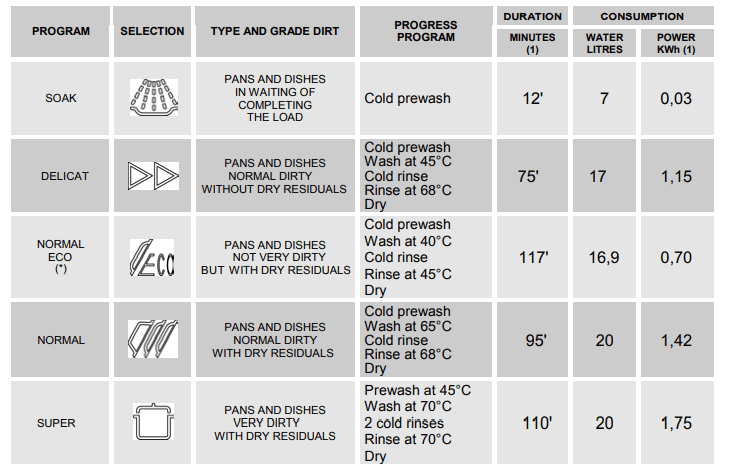
Only run the soak program with half loads.
The HALF LOAD option (6) is available for all programs except the soak program.
(*) Reference program as AS/NZS 2007 (NORMAL ECO).
(1) The cycle duration and power consumption may vary according to the water and room temperatures, and the type and amount of dishes.
WARNING: The washing cycle will not take place if the dishwasher door is left open or not properly closed.
TABLE FOR CERTIFICATION BODIES

NOTE: The door can be opened at the end of the cycle approximately 50 mm for improved drying performance.
AS/NZS 2007 cycle test conditions:
The upper basket must be set in the low position.
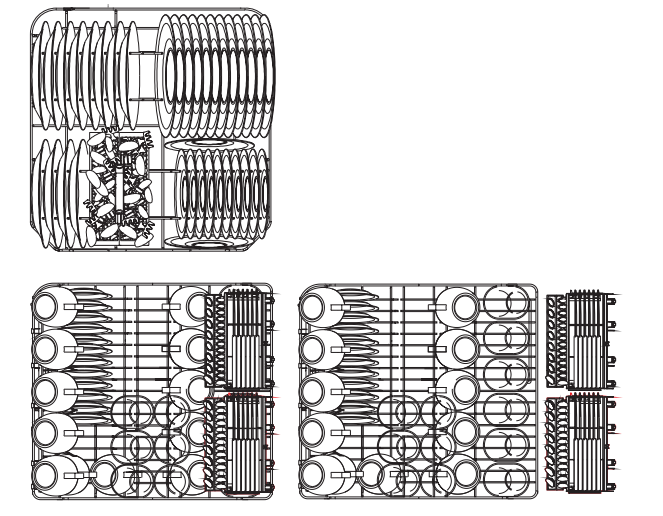
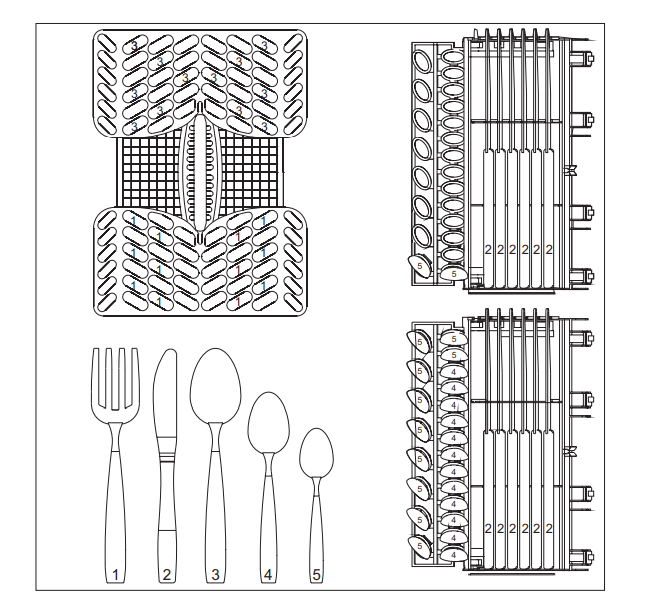
Washing programs
The dishwasher is equipped with a control panel, described in chapter "1. Description of the controls", from which it is possible to carry out all the power switch-on, switch-off and programming operations.
Before starting a washing program make sure that:
- The water supply tap is open.
- The correct amount of detergent has been added to the dispenser.
- The baskets have been correctly loaded.
- The spray arms are able to rotate freely and without obstruction.
- The dishwasher door is securely closed.
LIGHTING
When the ON/OFF button (1) is pressed, the dishwasher switches on. The ON/OFF (2) and START/PAUSE (4) lights will indicate one of the following states:
 Program start
Program start
Dishwasher ready to execute a new program.
 Program end
Program end
Door closed and washing program over.
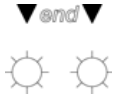 Alarm
Alarm
Alarm state (see chapter "Troubleshooting")

PROGRAMMING
All programming operations are only possible with the door closed. To select a new program, the dishwasher must be in the "Program start" state described above. Turn the PROGRAM SELECTOR (5) to the program of your choice (see "PROGRAMS TABLE").

START PROGRAM
Press the START/PAUSE button (3) for a few seconds, until the START/PAUSE light (4) starts to flash. A beep confirms the operation.
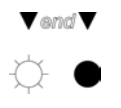
PROGRAM SEQUENCE
For the entire duration of the program, ON/OFF (2) indicator light remains permanently on, whereas the START/PAUSE (4) indicator light flashes.

END PROGRAM
To indicate the end of the program, a short beep sounds and the ON/OFF (2) and START/PAUSE (4) lights illuminate simultaneously.

Before a new washing cycle can be selected the dishwasher must be in "Program start" state: press the START/PAUSE button (3) until the configuration of indicator lights (2) and (4) is as follows.

INTERRUPTION OF A PROGRAM
Press the START/PAUSE button (3) for a few seconds, until the configuration of the ON/OFF (2) and START/PAUSE (4) lights is as follows.

You may now restart ("START PROGRAM") or change the program which was interrupted.
TO CHANGE A PROGRAM
To change the running program it is necessary:
- to interrupt the running program (see “INTERRUPTION OF A PROGRAM”);
- select the new program;
- to press again the START/PAUSE button (3) to make start the new program.

ANNULLING A PROGRAM
To annul the program in progress, it must first be interrupted (see “INTERRUPTION OF A PROGRAM”).
Turn the PROGRAM SELECTOR (5) to any point on the "empty" sector (with no symbols) on the left of the selector and start the dishwasher.
After the water has discharged from the tank, the ON/OFF (2) and START/PAUSE (4) lights will both remain on.

If the door is opened with the dishwasher in operation, the appliance switches to "Pause" state, indicated by a series of beeps and the following configuration of the ON/OFF (2) and START/PAUSE (4) lights.

Once the door has been closed again, the "START PROGRAM" procedure already described must be repeated. The washing cycle will restart from the point where it was interrupted.
In case that the tub temperature is higher than 50°C the program will start about 30 seconds later.
WARNING: If the dishwasher door is not properly closed, the washing cycle will not start.
HALF LOAD WASH FUNCTION (on some models only)
Pressing button ½ LOAD WASH (6) selects washing on the top basket only.
After selecting the program, proceed as follows:
- press the ½ LOAD WASH button (6) once to select washing in the top basket only;
- Press the button (6) again to return to the full load washing mode (washing in both baskets).
The option is disabled at the end of the cycle.
WARNING: dishes and cutlery placed in the basket not selected will not be washed.
INDICATOR LIGHT CONFIGURATION FOR HALF-LOAD WASHING (7)
 Washing in top basket only.
Washing in top basket only.
 Washing in both baskets.
Washing in both baskets.
TO SAVE ON ENERGY! … AND PROTECT THE ENVIRONMENT
- Always try to run the dishwasher fully loaded.
- Do not wash the dishes in running water.
- Use the washing program that is most appropriate for each type of load.
- Do not carry out any preliminary rinsing.
- If available, connect the dishwasher to a hot water supply up to 60°C.
TO CUT DOWN ON DETERGENT CONSUMPTION! … AND PROTECT THE ENVIRONMENT
The phosphates contained in dishwasher detergents are harmful to the environment. To avoid using excessive amounts of detergent and to save on electricity, observe the following:
- separate the more delicate items from dishes that are more resistant to aggressive detergents and high temperatures;
- do not pour the detergent directly on the dishes.
REMOVING THE DISHES
At the end of the washing program, wait at least 20 minutes before removing the dishes, to allow them to cool down. To prevent any water droplets on the upper basket from falling on the dishes in the lower basket, it is advisable to unload the lower basket first, and then the upper basket.
Operating instructions
Once the dishwasher has been correctly installed, prepare for use as follows: • Add the rinse aid and detergent.
- Add the rinse aid and detergent.
 ADDING THE RINSE AID
ADDING THE RINSE AID
The rinse aid helps the dishes dry faster and prevents the formation of scale deposits and staining; it is automatically added to the water during the final rinse cycle, from the container situated on the inner side of the door.

To add rinse aid:
- Open the door.
- Rotate the container cap anticlockwise by ¼ of a turn and remove it.
- Add the rinse aid until the container is full (approximately 140 cc). The optical level indicator on the side of the cap should be completely obscured. Refill the rinse aid when the optical level indicator becomes clear again, or when the rinse aid warning light illuminates.
- Replace the cover and turn it in a clockwise direction.
- Use a cloth to remove any spillage of rinse aid which might lead to the formation of excess foam.
ADJUSTING THE RINSE AID DISPENSER SETTING
The dishwasher is factory set for medium water hardness. However it possible to change the setting by turning the dispenser’s selector to the desired position: the amount of rinse aid dispensed is proportional to the selector position.
- To adjust the rinse aid setting, rotate the dispenser cap through a quarter turn in an anticlockwise direction and remove it.
- Then use a screwdriver to rotate the rinse aid selector to the desired position.
- Replace the cap, turning it clockwise.
- The amount of rinse aid must be increased if the washed dishes appear dull or feature circular stains.
- If, on the other hand, the dishes are sticky or have white streaks, it is necessary to reduce the rinse aid setting
ADDING THE DETERGENT
To open the detergent dispenser cap, lightly press the button P. Add the detergent and close the cap carefully.

During the washing cycle, the dispenser will be opened automatically.
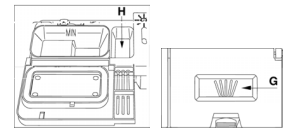
When a SUPER program is selected, in addition to the normal dose of detergent, it is necessary to add an additional amount inside compartment G or H.
- Use only detergents specially formulated for dishwashers. For optimal washing results it is important to use a good quality detergent.
- The detergent packs must be sealed and stored in a dry place to prevent the formation of lumps which may negatively affect washing results. Once opened the detergent packs should not be kept for too long, otherwise the detergent loses its effectiveness.
- Do not use detergents formulated for washing dishes by hand, because they produce a great deal of foam and may negatively affect the operation of the dishwasher.
- Add the correct amount of detergent. An insufficient amount of detergent will result in a partial removal of dirt from the dishes, whereas an excessive amount is wasteful and does not improve the washing results.
- The market offers liquid and powder detergents with differing chemical compositions, which may contain phosphates, or be phosphate-free but contain natural enzymes.
- Detergents containing phosphates are more effective against grease and starch at temperatures above 60°C.
See other models: OC70TZ OGG96A OG61XA ORF90X OCD4W
- Enzyme detergents, on the other hand, are also effective at lower temperatures (from 40 to 55°C) and are more easily biodegradable. With enzyme detergents it is possible to obtain at low temperatures comparable results to those which can only be achieved at 65°C using traditional detergents. For the safeguarding of the environment we recommend the use of phosphate- and chlorine free detergents. - Also available are tablet detergents which state that that no salt or rinse aid is required. In some cases, these detergents might not give good results, especially with short and/or low-temperature washing cycles. If performance problems (e.g. a white coating on the tank or dishes, poor drying, dirt on dishes at the end of the wash) are noted, users are advised to return to conventional products (granular salt, powder detergent and liquid rinse aid). However, please note that on return to the use of conventional salt, a number of cycles will be required before the system becomes fully efficient again, so traces of white coating may still be found on the tank and dishes. If the problem persists for too long, contact the After-Sales Service.
- When using detergent in tablet form (bear in mind that we recommend the use of three separate products: detergent, salt and rinse aid), place the tablets in the cutlery rack. The dispenser is designed to use powder or liquid detergent and the door does not open completely during the washing cycle. This means that a tablet is not completely dissolved (released), which may lead to the following:
- not enough detergent released during the cycle, with poor washing results;
- the detergent forms a solid block in the distributor and is released during the final rinse cycle.
WARNING: The introduction of detergent into the rinse aid dispenser, even in liquid form, will damage the dishwasher.
General warnings and recommendations
Before using the dishwasher for the first time, it is advisable to read the following recommendations concerning dish types to be washed and their loading. There are generally no constraints on the washing of domestic dishes, but in certain cases it is necessary to take their characteristics into account.
Before loading the dishes into the baskets it is necessary to:
- remove coarse food remains: e.g. bones, fish-bones, etc. which may clog the filter or damage the wash pump.
- soak any pots or pans with burnt-on food remains on the bottom to facilitate removal, then load them into the LOWER BASKET.
If a small quantity of dishes has to be washed, use the “½ load wash” option; this saves electricity and water. Remember to load the upper basket only; the lower basket must be left empty.
There is no need to pre-wash the dishes under running water before loading them into the baskets since this only wastes water.
Correct loading of the dishes helps ensure optimal washing results.
WARNING!
- Make sure that the dishes are securely in place so that they cannot tip over or obstruct the rotation of the spray arms during the washing cycle.
- Do not place very small objects in the baskets as these could fall and obstruct the spray arms or the wash pump.
- Containers such as cups, bowls, glasses and pots should always be loaded with the opening facing downwards and with any cavities at an angle, to allow the water to drain out.
- Do not stack dishes or place them in such a way that they cover one other.
- Do not place glasses too close together because they may knock against each other and break, or there might be staining at the point where they touch.
MAKE SURE that the items being washed are dishwasher-safe.
Items which are not dishwasher-safe:
- Wooden dishes, pots or pans: these may be damaged by the high washing temperatures.
- Handcrafted items: these are rarely suitable for washing in a dishwasher. The relatively high water temperatures and the detergents used may damage them.
- Plastic dishes: heat resistant plastic dishes must be washed in the upper basket.
- Dishes and objects in copper, tin, zinc or brass: these tend to stain.
- Aluminium dishes: items made from anodised aluminium may lose their colour.
- Silverware: silver items may stain.
- Glass and crystal: in general, glass and crystal objects can be washed in the dishwasher. However, certain types of glass and crystal may become dull and lose their clearness after many washings. Therefore, for these items we recommend using the least aggressive program available.
- Decorated items: the decorated objects available on the market are generally able to withstand washing in the dishwasher, although the colours may fade after a great many washes. If in doubt as to the fastness of the colours, it is advisable to wash just a few items at a time for approximately one month.
Using the baskets
The dishwasher has a capacity of 12 place-settings, including serving dishes.
LOWER BASKET
The lower basket receives the full force of the lower spray arm, and should therefore be used for the “toughest” items with a heavier degree of soiling.
All types and combinations of loads are permitted, provided that the dishes, pots and pans are arranged with all the soiled surfaces exposed to the water jets coming from the bottom.
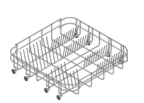
LOADING THE LOWER BASKET
Carefully load flat plates, soup plates, dessert and serving dishes, positioning them vertically. Pots, pans and their covers must be loaded upside down. When loading soup plates and dessert bowls, be sure to leave a gap between them.

CUTLERY BASKET
The basket has removable top grids into which items of cutlery can be inserted to keep them properly spaced and allow water to pass between them effectively.
The function of the central lid is only a cover. Do not add cutlery.
The cutlery should be arranged in an orderly manner inside the basket, with the handles pointing downwards. Take care during loading to avoid injury from the knife blades. The basket is suitable for all types of cutlery, except those long enough to interfere with the upper spray arm. Ladles, wooden spoons and cooking knives can be placed in the upper basket, making sure that the knife blades do not protrude from the basket.

UPPER BASKET
It is recommended to load the upper basket with small- or medium-sized items such as glasses, small plates, tea or coffee cups, shallow bowls and light objects made from heat resistant plastic. If the upper basket is used in the lowermost position, it can also be loaded with serving dishes, provided they are only slightly soiled.
The top basket is fitted (on the left) with two plastic racks which can be raised to make room for tall glasses, such as stem glasses. On the right there are two cutlery racks designed to take knives and teaspoons; when not in use, they can be left vertical, attached to the basket. To use the space designed for teaspoons, remove the insert as shown in the illustrations.
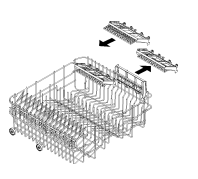
LOADING THE UPPER BASKET
Load the dishes with the top side facing forwards; cups and concave containers should always be loaded with the opening facing down. The left side of the basket can be loaded with cups and glasses on two levels. In the centre section, plates and saucers can be loaded vertically into the supports provided.

ADJUSTING THE UPPER BASKET
The upper basket can be adjusted in two positions, according to the user’s needs and according to the height of the dishes in the lower basket.
Proceed as follows:
- pull out the right-hand basket guide;
- remove the stop, first releasing it as shown in the diagram;
- push the guide to free the wheels;
- fit the upper or lower pair of wheels into the guide, depending on the setting required;
- return the stop to its original position.

Cleaning and maintenance
Before carrying out any work, always unplug the appliance from the electrical supply or switch off the all-pole disconnection device.
General warnings and recommendations
Avoid the use of acidic or abrasive detergents.
Clean the outer surfaces and door-lining of the dishwasher regularly using a soft cloth moistened with water or with a normal detergent suitable for painted surfaces. Clean the door gaskets with a damp sponge. Periodically (once or twice a year) it is advisable to clean the tank and gaskets, using a soft cloth and water to remove any deposits.
CLEANING THE WATER INTAKE FILTER
The water intake filter A located at the outlet of the water supply tap needs to be cleaned periodically.
After having closed the water supply tap, unscrew the end of the water intake hose, remove the filter A and clean it delicately under running water. Reassemble filter A in its seat and carefully screw the water intake hose back into position.
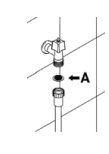
CLEANING THE SPRAY ARMS
The spray arms can be easily removed for periodic cleaning of the nozzles, to prevent possible clogging. Wash them under running water and carefully replace them in their seats, checking that their rotary movement is in no way impeded.
- To remove the upper spray arm, unscrew locking ring R.
- To remove the lower spray arm, simply lift it up, pulling by the central part.
- To remove the orbital spray arm assembly, take hold of the longer arm and pull the orbital unit upward. Wash the arms under a jet of running water and return them carefully to their seat. After reassembly, check that the spray arms turn freely. Otherwise, check that they have been installed correctly.
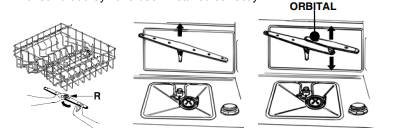
CLEANING THE FILTER UNIT
- It is advisable to periodically inspect the centre filter C and, if necessary, to clean it. To remove the filter, grip the tabs, turn them anticlockwise and lift upwards;
- push the centre filter D from the underside to remove it from the micro-filter:
- separate the two parts which make up the plastic filter by pressing the body of the filter in the zone shown by the arrows;
- remove the centre filter by lifting it upwards.

GENERAL WARNINGS AND RECOMMENDATIONS FOR CORRECT MAINTENANCE:
- The filters should be cleaned under running water using a stiff brush.
- It is essential to thoroughly clean the filters according to the above instructions: the dishwasher cannot function if the filters are clogged.
- Carefully replace the filters in their seats, to avoid damaging the wash pump.
PROLONGED DISUSE:
- Run the soak program twice in succession.
- Unplug the power cord from the socket.
- Leave the door slightly open, in order to prevent the formation of unpleasant odours inside the washing tank.
- Fill the rinse aid dispenser.
- Shut off the water supply tap.
BEFORE STARTING THE DISHWASHER AFTER PROLONGED DISUSE:
- Check that there are no deposits of sludge or rust inside the water pipe: if there are, allow the water to run from the water supply tap for a few minutes.
- Plug the power cord back into the socket.
- Reconnect the water intake hose and open the tap again.
TROUBLESHOOTING MINOR PROBLEMS
In some cases it is possible to remedy minor problems by referring to the following instructions:
If the program fails to start, check that:
- the dishwasher is connected to the electrical power supply;
- there is no power failure;
- the water tap is open;
- the dishwasher door is properly closed.
If water remains inside the dishwasher, check that:
- the drain hose is not kinked;
- the drain siphon is not obstructed;
- the dishwasher filters are not clogged.
If the dishes are not being cleaned properly, check that:
- the correct amount of detergent has been added;
- the dishes are being loaded correctly;
- the selected program is suitable for the dish types and their degree of soiling;
- all the filters are clean and positioned correctly;
- the spray arm nozzles are not obstructed;
- there is no object obstructing the rotation of the spray arms.
If the dishes fail to dry or remain dull, check that:
- there is rinse aid inside the special container;
- the rinse aid dispenser setting is correct;
- the detergent used is of good quality and has not lost its effectiveness (for example, through incorrect storage, with the box left open).
If the dishes show signs of streaking, staining, etc., check that:
- the rinse aid dispenser setting is not too high.
If there are visible traces of rust inside the tank:
- the tank is made of steel, and therefore any rust marks are due to external elements (fragments of rust from the water pipes, pots, cutlery, etc.). Special products are commercially available to remove such marks;
- check that the amount of detergent being used is correct. Certain detergents can be more corrosive than others;
If after following the above troubleshooting instructions the problem persists, call the nearest After-Sales Centre.
WARNING: any operations performed on the appliance by unauthorised persons are not covered by the warranty and shall be paid for by the user.
Troubleshooting
In case of a malfunction, the dishwasher will warn the user by flashing the ON/OFF (2) and START/PAUSE (4) lights, in some cases combined with a continuous beep.
| LIGHTS | DESCRIPTION |
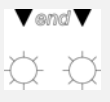 |
|
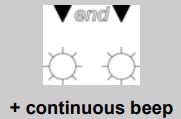 |
|
In some cases, the alarm signal may indicate a temporary problem, so before contacting the after-sales service, proceed as follows.
- Open and close the door, or switch the dishwasher off and back on, and if necessary reprogram it.
If the problem persists, contact the after-sales service.
TECHNICAL DATA
| Width | 597 ÷ 599 mm |
| Depth measured flush with the outer edge of the control panel |
Free standing: 600 mm Semi-integrated: 570 mm |
| Height |
Free standing from 850 mm to 870 mm Semi-integrated from 820 mm to 870 mm |
| Capacity | 12 Standard place settings |
| Water supply pressure | min. 0,05 - max. 0,9 MPa (min. 0.5 – max. 9 bar) |
| Electrical characteristics | See rating plate |
